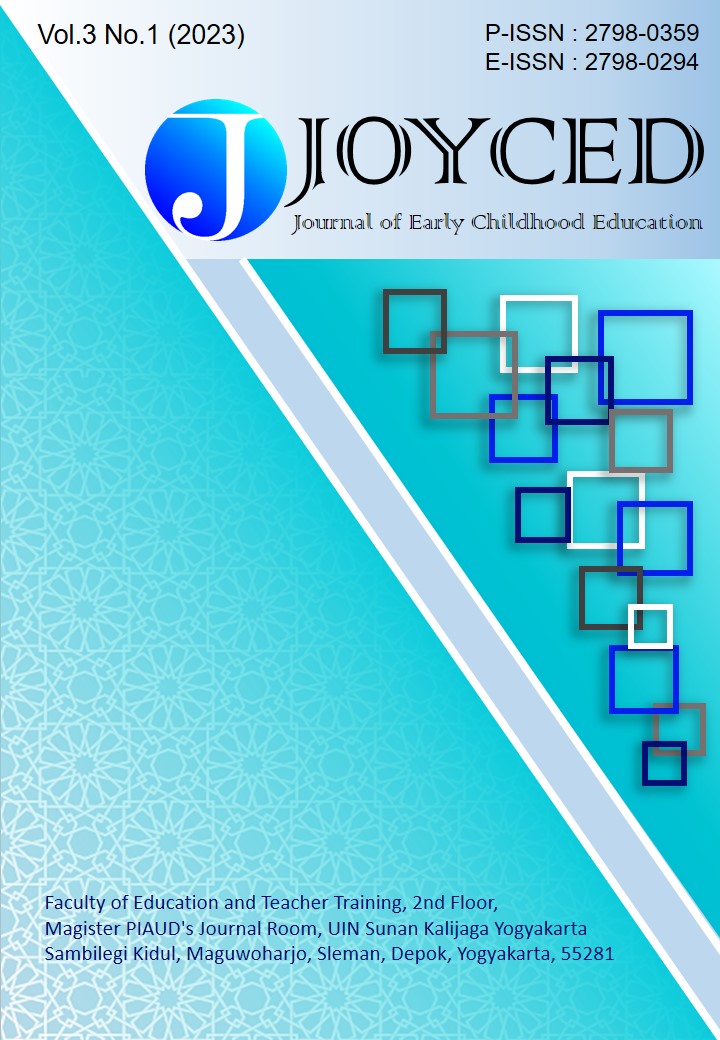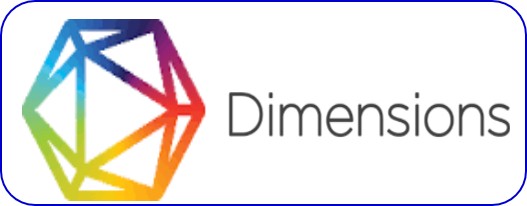Heutagogical Approach in Play and Games Courses of Early Childhood in Online Learning
DOI:
https://doi.org/10.14421/joyced.2023.31-05Keywords:
Heutagogical Approach, Online Learning, Children's Play CourseAbstract
This study aims to describe the use of hetagogy approaches in early childhood play and play courses during the online learning phase in the Early Childhood Islamic Education and Research Program at Sultan Taha Jambi National Islamic University. Because of the COVID-19 pandemic, the lecture process will be conducted via distance learning. This is often called online education. However, the effect of absorbing teaching materials is reduced. Due to the lack of active interaction and being limited to online screens, different learning approaches, such as the hetagogy approach, are being used to re-streamline learning in the online classroom. Has been introduced. This study uses Miles and Huberman's interactive model as a case study of data analysis techniques. Data collection from interviews with 26 students and one lecturer. This research shows that students with a bullish approach encourage more active faculty-student interaction and collaboration, exchange ideas, critical thinking, independence, and successful communication research projects. By doing so, we demonstrate that we are having a positive impact.
Downloads
References
Anderson, T. (2010). Theories For Learning With Emerging Technologies.
Blaschke, L. M. (2012). Heutagogy And Lifelong Learning: A Review Of Heutagogical Practice And Self-Determined Learning. In International Review Of Research In Open And Distance Learning, 13(1), 56–71. Https://Doi.Org/Https://Doi.Org/10.19173/Irrodl.V13i1. 1076
Dewantara, P. M. (2021). Ict & Pendekatan Heutagogu Dalam Pembelajaran Abad Ke 21. Grup Penerbitan Cv Budi Utama.
Fitrah, M., & Luthfiyah. (2017). Metodelogi Penelitian Kualitatif, Tindakan Kelas & Studi Kasus. Cv Jejak.
Hase, S., & Kenyon, C. (2000). From Andragogy To Heutagogy. Ultibase Articles, 5, 1–10.
Helmansyah, H., Prawira, Y. A., & Nugraha, F. (2021). Menimbang Pelatihan Daring: Respon Dan Harapan Di Masa Pandemi Covid-19. Jurnal Persfektif, 14(1), 161–179.
Hiryanto. (2017). Pedagogi, Andragogi Dan HeutagogySerta Implikasinya Dalam Pemberdayaan Masyarakat. Dinamika Pendidikan, 22, 65–71.
Hotimah, Ulyawati, & Raihana, S. (2020). Pendekatan HeutagogyDalam Pembelajaran Di Era Society 5.0. Jurnal Ilmu Pendidikan, 1(2), 152–159.
Mohammad, S., Siang, T. C., Osman, S., Jamaluddin, N. Y., Alfu, N. A. M., & Huei, L. Y. (2019). A Proposed Heutagogy Framework For Structural Steel Design In Civil Engineering Curriculum. International Journal Of Emerging Technologies In Learning, 14(24), 96–105. Https://Doi.Org/10.3991/Ijet.V14i24.12091
Muhid, A. (2021). HeutagogyKemerdekaan Mahasiswa Belajar Di Era Revolusi Digital. Intelligentsia Media.
Noor Muslieah, M. K., Zaharah, H., Abdul Muhsien, S., & Nurul Nadia, A. L. (2021). Application Of Heutagogy In Home-Based Learning Use Of M-Learning. Journal Of Islamic Educational Research, 7, 2021.
Obradovic, S., Bjekic, D., & Zlatić, L. (2015). Creative Teaching With Ict Support For Students With Specific Learning Disabilities. Procedia - Social And Behavioral Sciences, 203. Https://Doi.Org/10.1016/J.Sbspro.2015.08.297
Permendikbud, R. Dan T. (2020). Surat Edaran Mendikbud No 4 Tahun 2020 Tentang Pelaksanaan Kebijakan Pendidikan Dalam Masa Darurat Penyebaran Corona Virus Disease (Covid- 1 9) – Pusat Pendidikan Dan Pelatihan Pegawai Kemendikbudristek. 2020.
Peters, O. (2001). Learning And Teaching In Distance Education: Analyses And Interpretations From An International Perspective (Open And Flexible Learning Series) 1st Edition. Routledge.
Prawira, Y. A., Ayundhari, V. L., Diklat, B., Bandung, K., Kurnia, T., Pendidikan, D., & Bandung, K. (2021). Exploring Students’ Affective On Using Asynchronous Learning During The Pandemic Period. 7(1), 33–50. Https://Doi.Org/10.15575/Jpi.V7i1.9740
Prawira, Y. A., Rachmawati, R., Diklat, B., & Bandung, K. (2022). Edukatif : Jurnal Ilmu Pendidikan. 4(3), 4170–4179.
Sari, K. M. (2020). Kompetensi Pedagogik Guru Dalam Melaksanakan Penilaian Pembelajaran Anak Usia Dini. Jurnal Obsesi : Jurnal Pendidikan Anak Usia Dini, 4(2), 900. Https://Doi.Org/10.31004/Obsesi.V4i2.478
Stoten, D. W. (2021). Building Adaptive Management Capability: The Contribution Of Heutagogy To Management Development In Turbulent Times. Journal Of Management Development, 40(2), 121–137. Https://Doi.Org/10.1108/Jmd-10-2019-0448
Sulistya, R. (2019). Heutagogy As A Training Approach For Teachers In The Era Of Industrial Revolution 4.0. Pendidikan Dan Kebudayaan, 4(2), 127–138.
Sumarmo, U. (2004). Kemandirian Belajar: Apa, Mengapa, Dan Bagaimana Dikembangkan Pada Peserta Didik. Seminar Pendidikan Matematika Di Jurusan Pendidikan Matematika Fmipa Universitas Negeri Yogyakarta. Https://Doi.Org/Http://Doi.Org/10.1111/J.1095-8312.2011.01677.X
Tjandra, E., & Santoso, I. C. (2018). Metodologi HeutagogyDalam Perspektif Keilmuan Di Bidang Desain Interior Pada Era 4 . 0. Seminar Nasional Seni Dan Desain: “Konvergensi Keilmuan Seni Rupa Dan Desain Era 4.0, 98–103. File:///Users/Lea/Onedrive/Mendeley 2.0/2020_Metodologi HeutagogyDalam Perspektif Keilmuan Bidang Desin.Pdf
Wheeler, S. (2015). Learning With ’E’s: Educational Theory And Practice In The Digital Age.






.png)











